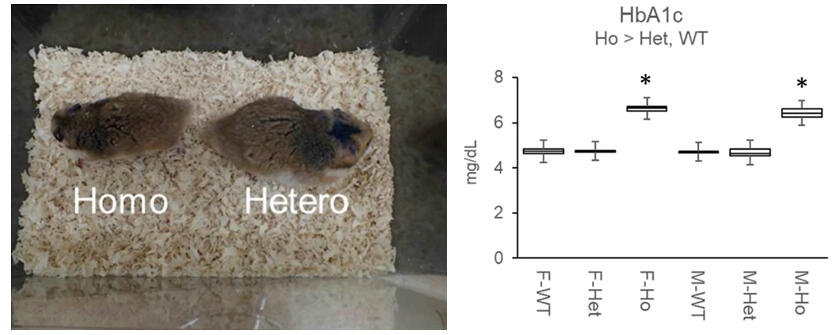Type 2 diabetes is caused by both environmental factors, such as lifestyle, and genetic predispositions. While most patients with the disease in Western Europe are obese, those with nonobese type 2 diabetes account for the majority in East Asia, including Japan. However, previously available models of type 2 diabetes have been mostly for the obese type.
A joint research group comprising Technical Staff II Michiko Hirose and Director Atsuo Ogura from the Bioresource Engineering Division, Director Masaru Tamura of the Mouse Phenotype Analysis Division at RIKEN BioResource Research Center; and Assistant Professor Takaaki Murakami and Professor Emeritus Nobuya Inagaki of the Department of Diabetes, Endocrinology, and Nutrition, Graduate School of Medicine at Kyoto University successfully developed a nonobese diabetes model animal by engineering a gene in hamsters. The work was published in Scientific Reports.

Homozygous KO hamsters showed continuously low body weight from birth. Homozygous KO hamsters are smaller than heterozygous KO (left).
Homozygous KO hamsters had significantly higher HbA1c levels than heterozygous KO and wild-type hamsters (right).
Provided by RIKEN
Using golden hamsters, which have carbohydrate and lipid metabolism similar to humans, the joint research group successfully developed a non-obese diabetes model hamster. This was achieved by applying improved genome-editing via oviductal nucleic acid delivery (i-GONAD) to knockout (KO) the IRS2 (insulin receptor substrate 2) gene, one of the genes associated with diabetes. Homozygous KO hamsters exhibited lower body weight from birth than heterozygous KO and wild-type hamsters. They also showed significantly higher blood glucose and HbA1c levels, which reflects blood glucose levels over the past 1−2 months, than wild-type hamsters.
In the glucose load test, homozygous KO hamsters had significantly higher blood glucose levels than heterozygous KO or wild-type hamsters. These levels remained elevated for 120 minutes after glucose administration. In the insulin tolerance test, homozygous KO hamsters reacted normally to insulin administration. Glucose-induced insulin secretion tests showed no insulin increases in homozygous KO hamsters. These results suggest inadequate function of pancreatic β-cells, which secrete insulin, in homozygous KO hamsters.
The examination of pancreatic β-cells via immunohistochemistry revealed that the relative area of insulin-positive cells was significantly reduced in homozygous KO hamsters and that islets containing β-cells were also smaller than those in heterozygous KO hamsters. Insulin secretion tests using islets isolated from the pancreas showed that insulin secretion per islet and insulin content were significantly lower in homozygous KO hamsters. The insulin secretion and insulin content per islet cell were also decreased in homozygous KO hamsters. These are indicative of β-cell dysfunction in homozygous KO hamsters, supporting the results of the in vivo glucose metabolism tests.
Diabetes, including subclinical diabetes, affects an estimated 20 million or more people in Japan, many of whom have non-obese diabetes unique to East Asia. The hamsters developed in this study represent a valuable experimental model that can be used to elucidate the pathogenic mechanism of diabetes in Japan and to develop treatment methods.
Journal Information
Publication: Scientific Reports
Title: Disruption of insulin receptor substrate 2 (IRS2) causes non-obese type 2 diabetes with β-cell dysfunction in the golden (Syrian) hamster
DOI: 10.1038/s41598-024-67513-9
This article has been translated by JST with permission from The Science News Ltd. (https://sci-news.co.jp/). Unauthorized reproduction of the article and photographs is prohibited.




